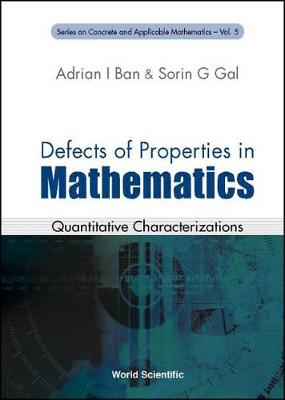Series on Concrete & Applicable Mathematics
3 primary works
Book 5
Defects Of Properties In Mathematics: Quantitative Characterizations
by Adrian I. Ban and Sorin G Gal
Published 23 April 2002
This book introduces a method of research which can be used in various fields of mathematics. It examines, in a systematic way, the quantitative characterizations of the "deviation from a (given) property", called the "defect of a property", in: set theory; topology; measure theory; real, complex and functional analysis; algebra; geometry; number theory; fuzzy mathematics.Besides well-known "defects", the book introduces and studies new ones, such as: measures of noncompactness for fuzzy sets; fuzzy and intuitionistic entropies; the defect of (sub, super)additivity; complementarity; monotonicity for set functions; the defect of convexity; monotonicity; differentiability for real functions; the defect of equality for inequalities; the defect of orthogonality for sets and defects of properties for linear operators in normed spaces; defects of properties (commutativity, associativity, etc.) for binary operations; defects of orthogonality and parallelness in Euclidean and non-Euclidean geometries; defects of integer, perfect, prime and amicable numbers; the defect of tautology in fuzzy logic.
Book 8
Approximation by Complex Bernstein and Convolution Type Operators
by Sorin G Gal
Published 11 August 2009
The monograph, as its first main goal, aims to study the overconvergence phenomenon of important classes of Bernstein-type operators of one or several complex variables, that is, to extend their quantitative convergence properties to larger sets in the complex plane rather than the real intervals. The operators studied are of the following types: Bernstein, Bernstein-Faber, Bernstein-Butzer, q-Bernstein, Bernstein-Stancu, Bernstein-Kantorovich, Favard-Szasz-Mirakjan, Baskakov and Balazs-Szabados.The second main objective is to provide a study of the approximation and geometric properties of several types of complex convolutions: the de la Vallee Poussin, Fejer, Riesz-Zygmund, Jackson, Rogosinski, Picard, Poisson-Cauchy, Gauss-Weierstrass, q-Picard, q-Gauss-Weierstrass, Post-Widder, rotation-invariant, Sikkema and nonlinear. Several applications to partial differential equations (PDEs) are also presented.Many of the open problems encountered in the studies are proposed at the end of each chapter. For further research, the monograph suggests and advocates similar studies for other complex Bernstein-type operators, and for other linear and nonlinear convolutions.
Book 14
Evolution Equations With A Complex Spatial Variable
by Ciprian G Gal, Sorin G Gal, and Jerome A Goldstein
Published 1 January 2014
This book investigates several classes of partial differential equations of real time variable and complex spatial variables, including the heat, Laplace, wave, telegraph, Burgers, Black-Merton-Scholes, Schroedinger and Korteweg-de Vries equations.The complexification of the spatial variable is done by two different methods. The first method is that of complexifying the spatial variable in the corresponding semigroups of operators. In this case, the solutions are studied within the context of the theory of semigroups of linear operators. It is also interesting to observe that these solutions preserve some geometric properties of the boundary function, like the univalence, starlikeness, convexity and spirallikeness. The second method is that of complexifying the spatial variable directly in the corresponding evolution equation from the real case. More precisely, the real spatial variable is replaced by a complex spatial variable in the corresponding evolution equation and then analytic and non-analytic solutions are sought.For the first time in the book literature, we aim to give a comprehensive study of the most important evolution equations of real time variable and complex spatial variables. In some cases, potential physical interpretations are presented. The generality of the methods used allows the study of evolution equations of spatial variables in general domains of the complex plane.


